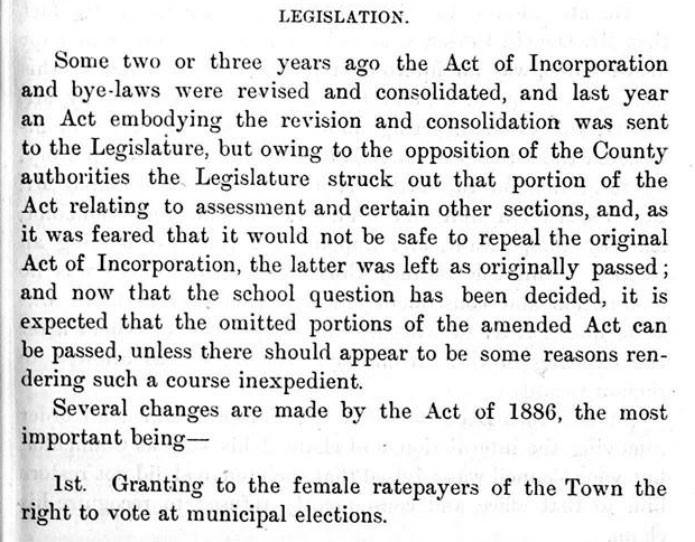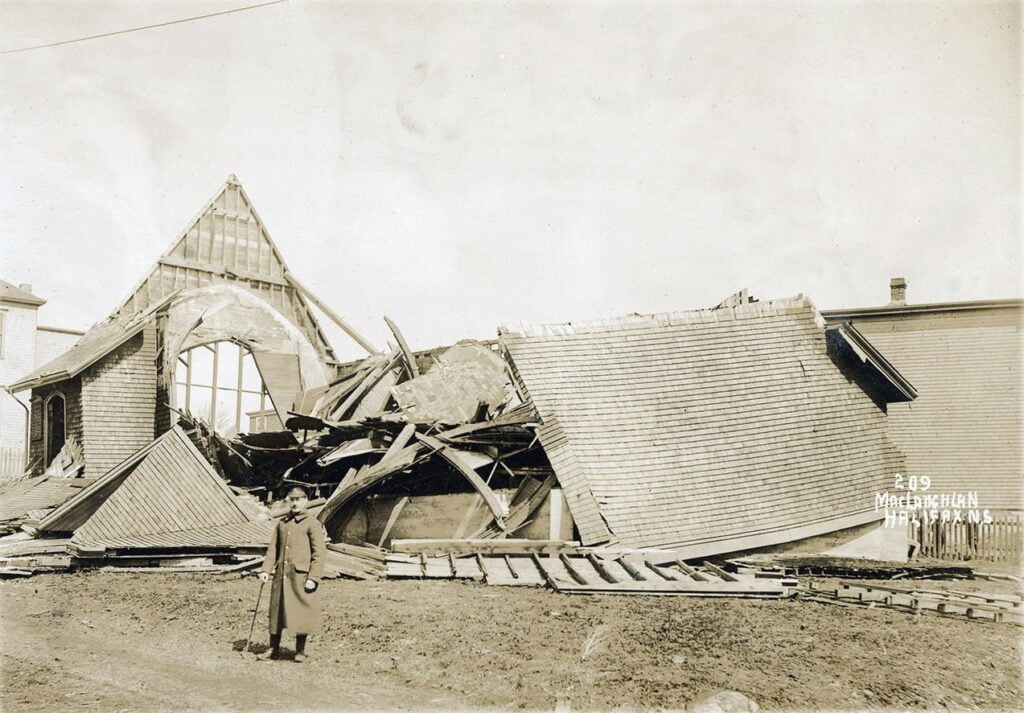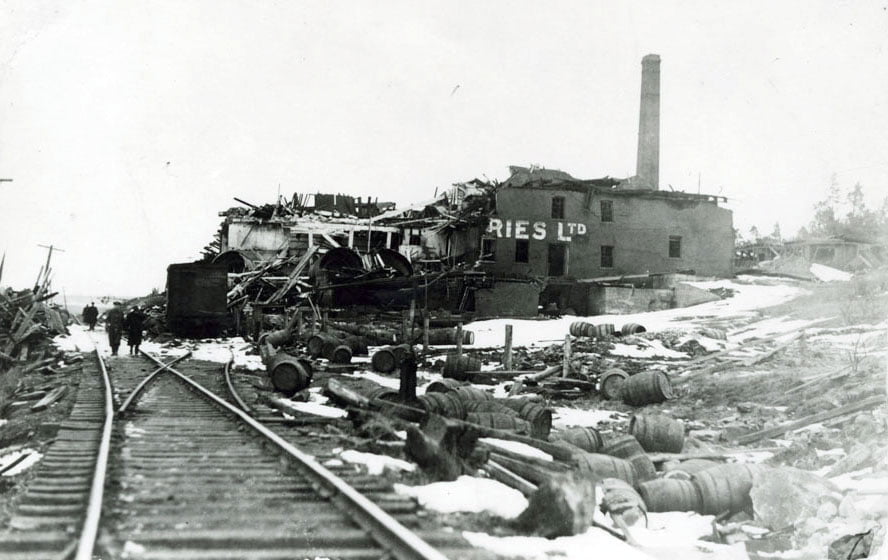BEGINNINGS OF WOODSIDE
“Woodside” was the name of a beautiful rural estate, commanding a full view of the harbor, which was laid out about 1830 for Hon. John E. Fairbanks. The description of these highly ornamental grounds occupies a whole page in Mrs. Lawson’s History of Dartmouth. His private duck-pond was across the main road in that filled-in oval running westerly from the present base-ball park. The old Fairbanks dwelling is still used as a recreation hall. All that residential section of South Woodside commenced developing when the “Company” houses were constructed in 1886. The first sugar refinery, composed largely of brick, was erected in 1884, and destroyed by fire in 1912. The present building occupies much of the old site. There has been no sugar refined at this plant since June 1942. The stoppage was caused by world conditions during the war.
Along the railway track nearly to the boundary of the Nova Scotia Hospital, the hollowed-out bank indicates the situation of the old pottery works, and mill for the manufacture of chocolate and cocoa started in the 1830’s by Henry Y. Mott. If is said that the Mott family were among the first to make chocolates in what is now Canada. The Mott homestead was built on the present location of the new brick building just south of the main Nova Scotia Hospital. About 1909, the Grant family moved the house where it now stands next south of St. Alban’s Church.
The first record of another new hotel in Dartmouth is noted in newspapers of 1830 when on January 9 there is an account of a distinguished party in town. The report says:
Rear Admiral Sir Charles Ogle, the Lord Bishop of Nova Scotia, and Hon. Michael Wallace, the Treasurer of the Province, visited the Canal yesterday, and afterwards dined together at Medley’s Hotel in Dartmouth, where a sumptuous fare was provided in handsome style for them.
Medley’s Hotel was at the present Central Apartments on 59 Queen Street, owned at that time by Hon. Mr. Wallace. It outlasted all the other local inns of the 19th century.
In April 1830, a Boarding and Day School was opened in a large wooden house at the northeast corner of Commercial and Portland Streets. The announcement reads:
Mrs. Pratt, from London, most respectfully announces to the inhabitants of Halifax and Dartmouth, that she intends opening a Boarding and Day Seminary for young ladies, at the house of Mr. Lowe, opposite the Steam Boat wharf.
In May, word came from Charles R. Fairbanks in London that he had been successful in obtaining a loan of £20,000 from the British Government. In addition, £27,000 worth of shares of Canal stock had been purchased by private subscription.
It is of interest to record here that Dartmouth received considerably publicity as a result of Mr. Fairbanks’ visit. Famous men in the House of Lords who debated the Shubenacadie Canal Bill, included Lord Durham and the Duke of Wellington. The former was firmly opposed to the measure, while the latter seemed to be favorable to the loan.
The newspapers about this time had many more items concerning Dartmouth, than ever before. The Canal cottages were no doubt along Ochterloney Street for the convenience of workmen at the new Circular Dam and the new Locks near the Starr Works, as the following newspaper item suggests:
DARTMOUTH—Several new houses have been erected this spring. Others are being repaired and enlarged. A few rods above the Church, a new village has arisen almost spontaneously in the wilderness. The Dartmouth Canal Locks are progressing rapidly, and on a working day a visitor may see in miniature, some of the wonders of art which we hear of from other countries.
The poetry of “Albyn” continued to appear in Joseph Howe’s newspaper. Early in 1830, he wrote a 15-verse rhapsody, entitled SPRING’S WAKE. We quote two verses:
Birds from the East and West Know their appointed time, Thrice welcome, ev’ry aerial guest, Come to repair its ruined nest, Or sport on beds of thyme. The field-fare, in a flock, Have spread their pilgrim wings The ravens round Cole-Harbor croak, And geese that come ‘like clouds of smoke’, There stay their travellings. SPRING’S WAKE
The first casualty on the “Sir Charles Ogle” occurred in April. A young man in the employ, descended into the boiler for the purpose of cleaning it out, without first ascertaining if the fixed air had escaped. The result was instantly fatal.
Trouble soon developed on the Steam Boat, for in July she ceased running for a time. This is inferred from a complaint in the papers by a Halifax resident who went down to the Halifax dock with a group intent on a trip in the Steam Boat. After trying for two days, they had to “cross in one of Findlay’s barges”. At Dartmouth they found 14 or 15 teams laden with produce which had been detained on that side for several days, and at their own expense.
Meantime Joseph Findlay at the Old Ferry Inn, was taking every opportunity to encourage travelers to use his route. His card of July 1830, announced:
Joseph Findlay begs leave to return his sincere acknowledgements to the public, for the many marks of their kindness shewn him since he commenced his establishment at the Lower Ferry, Dartmouth, and likewise informs them that he has erected a convenient BATHING HOUSE near his wharf, where the water is pure. Adults can be accommodated at 3d each and children half price. Tea and Refreshments as usual.
There was no regatta on the harbor that summer. Other matters engaged public attention. On Sunday, August 1, a barque arrived at Saint John, N.B., with Dublin newspapers announcing the death of George IV. Halifax got the news on Wednesday night’s stage-coach from Annapolis.
The Legislature was consequently dissolved, and the Province plunged into the heat of a general election, for this was the year of the famous “Brandy Dispute”.
The brilliant S. G. W. Archibald, of Truro, led the poll in Halifax County, which then extended to Pictou. He subsequently became Speaker of the new House. Our fellow townsman and late member, Lawrence Hartshorne, was not re-elected.
Of particular interest at that time was the circumstance that of the two European Sovereigns who had just ascended Thrones, at least one, and probably both, had trod the soil of Dartmouth. They were King Louis Phillippe of France, and William IV of England.
The former visited Preston, and the latter was on this station in command of H. M. S. “Pegasus” forty-odd years previously. It will be recalled that the fort at Eastern Battery was re-named after Prince William when he became the Duke of Clarence.
Proof that Dartmouth was used as the main route of no. 2 Highway is shown by an occurrence in August of 1830. The Eastern Stage Coach, due on a Saturday evening, did not get to Dartmouth until Sunday morning, owing to accidents on the road. Davidson, the driver, complained afterward, that they had reached here just as the 8 o’clock ferry was docking. Despite his pleas to Captain Hunter that he carried English mail for H.M.S. “Pallas”, which was on the eve of sailing, the driver and his passengers were compelled to wait for nearly an hour while the Steam Boat crew went off to breakfast.
All the lands of the late Jonathan Tremain were advertised to be sold at auction that summer. Included was his country seat, already mentioned. His 12-acre field, containing a house, a garden and a wharf on the waterfront, was purchased by Joseph Hamilton of Halifax. Hence the Hamilton fields.
An old plan of the field shows that there was a proposed thoroughfare called “King William Street”, which was to extend from Canal Street to Maitland. It was to run parallel with Portland Street, about half way to the shore.
The northwest section of this field [, where now stands the Dartmouth Medical Centre, was acquired by William Foster, son of Edward Foster. The Foster deed of 1830, described the property as being “120 feet on Canal Street and 138 feet on the road to Creighton’s Ferry”. Foster’s corner was a landmark of last century. For many years they operated a tobacco factory at this spot, manufacturing plug tobacco.
There was also for sale a 50-acre Tremain lot bordering Dartmouth Common on what is now the upper side of Victoria Road extending from about Brightwood Avenue to Boland Road. A plan of the area shows that School Street divides the property which has one lone house standing near the present southeast corner of Slayter Street and Gladstone Avenue. The description says that the land was “partly improved, but mostly studded with a growth of spruce, birch, beech and oak trees”.
The plan divides the land on the southern side of School Street into four oblong-shaped lots of about five acres each, while four others on the opposite side contain about seven acres. The whole of the estate, which comprised a great part of the present golf greens, was called “Abbeville” probably after Mrs. Tremain whose Christian name was Abigail.
A name that was prominent in real estate holdings in Dartmouth for over a century was that of Allan McDonald. There were three generations of them. The first Allan carried on a tobacco and cigar manufactory along with a stock of general merchandise including liquors, at 48 Bedford Row in Halifax. The building which now stands at no. 78 is perhaps the same one.
Allan McDonald’s name first appears on property deeds in 1830, when he bought 50 acres of land from John Elliott at Russell’s Lake; and eight additional acres from Nathaniel Russell. Hence McDonald’s Lake. Older maps name it Morris’ Lake. In course of time a flour mill and snuff mill were erected there.
The newly elected Provincial Legislature convened in November. They heard more ferry complaints. A petition, signed by several Dartmouthians was sent in by Peter Donaldson, asking permission to run a competitive ferry from his wharf on the shore below the present no. 11 Commercial Street.
The petitioners stated that the fare was now four pence instead of 3p as formerly charged on Skerry’s boats. Furthermore the Magistrates had recently made a regulation forbidding any landings within a certain distance of the Steam Boat wharf. As a consequence, passengers on Findlay’s boats from Halifax, had to be landed in the Cove. The petition was refused.
Deaths in 1830 included Thomas Barrons, a Canal workman, killed by falling 20 feet from the top of Lock no. 6, (the Channel). In September, James Purvis and Patrick Riley were drowned from one of Findlay’s small ferries while crossing from Halifax to Dartmouth in a violent wind and rain.
Dr. James Boggs died at Halifax in his 91st year. At Lake Loon, Mary Ann Morris, daughter of Hon. Charles Morris, died aged 20; and at Preston, Miss Eleanor Simpson, aged 42. At Warren’s Hotel, Dartmouth, died Jeane, wife of Capt. Richard Gethen, 96th Regt., leaving a young family.
Marriages that year included a fashionable one at Mount Edward by the Rev. M. B. DesBrisay, of Frances Mary Brinley, daughter of the late W. B. Brinley, Esq., to William Lawson, junior. Other nuptials performed by the same Minister were those of Sarah Rogers, daughter of John Rogers, to Thomas Medley; and Mary Ann Marvin to Joseph Robinson.
Rev. James Morrison officiated at the weddings of Mrs. Jane Bell to John Meagher; Elizabeth Green to George Irvin; and Jane Albro to James Hall, Esq. The last named was a brother to Engineer Francis Hall, the husband of Mary Albro.
The first Roman Catholic marriage was recorded in October 1830, when Captain Michael Dormandy was united to Mrs. Mary Shortell, by Rev. James Dunphy of the new St. Peter’s Church.
Baptisms that year were Rebecca, child of Rose and Wm. Walker, schoolmaster; Ann, child of Dorothy and Thos. Marvin, shipbuilder; Edward, child of Eliza and Chas. Allen, shipbuilder.
Many rural members of the Legislature remained in Halifax for Christmas in 1830, for the House sat through the holidays to finish up business, and finally prorogued in mid-January of 1831. A bonus of £250 yearly until 1834 was voted the Eastern Stage Coach. The Steam Boat got a grant of £190.
The Company’s petition stated that they now had a valuable steamboat and enlarged wharf accommodation. The year’s expenses had exceeded £4,000, making the total outlay to date over £12,000. From this investment, shareholders had never received a shilling of dividends. Appended to the petition were lengthy sheets filled with signatures, or symbols, of Company supporters both in Halifax and Dartmouth.
Despite all this backing, the ferry service was unsatisfactory because the “Sir Charles Ogle” gave considerable trouble, and sometimes had to cease running. Salt water, which was used in her boiler, kept clogging the tubes. Frequently fires had to be drawn, in order to clean out the crusting of salt. During three weeks in the early winter of 1831, she was laid up for ten days. Teams arriving with country produce, were put to the necessity either of selling their supplies at a loss in Dartmouth, or of driving around the Basin to Halifax market.











